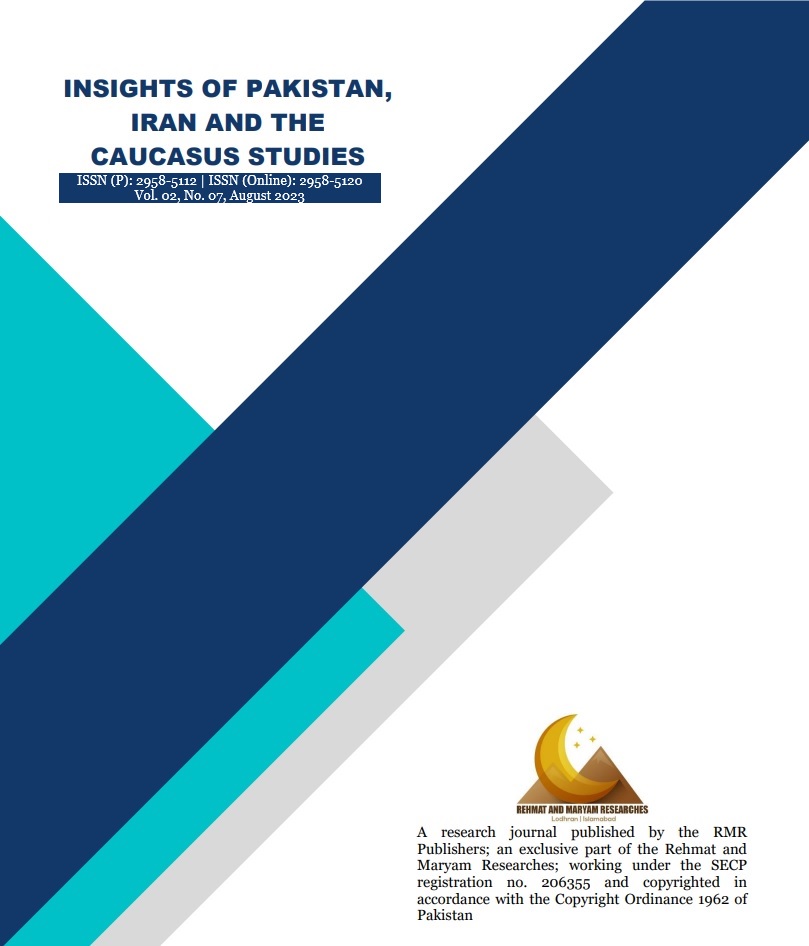Khorasan: Symbolism in Shia Islam and its Relevance to Dr. Asim’s Vision of “Romanticizing Afghanistan, Iran and Pakistan” and “Establishing a Jointly Administrative Market at Tri-Borderland”
Keywords:
Kitab al-Masalik wal-Mamalik, Al-Biruni, Kitab al-Hind, Geography of Khorasan, Islamic eschatology, Army with Black FlagsAbstract
Khorasan holds great significance in Shia tradition, being associated with the emergence of the Mahdi, the 12th Imam. The narrations and quotations related to Khorasan in Shia Islam provide a historical and religious context that shapes the understanding of its importance. The paper begins with an account of the author’s introduction to Dr. Asim’s proposal for a jointly administered market at the Pak-Iran-Afghan tri-borderland. Drawing from related literature and the author’s expertise as a political analyst on Iran, the author embarked on an exploration of this emerging policy. The author’s prior works and discussions further fueled their interest in the subject, leading to the presentation of this idea at various academic conferences and subsequent publications.
Furthermore, the research paper examines the interpretation of the feasibility report prepared by Dr. Asim for the proposed market. It highlights the potential for strengthening the regional social economy and the socio-cultural bonds between Pakistan, Iran and Afghanistan. The establishment of a jointly administered market is expected to have positive impacts on the economy, lifestyle, literacy rates and social cohesion of the borderland regions. Additionally, it explores how this market can contribute to regional peace, interdependence, and the strengthening of regional self-sufficiency.
Moreover, the study analyzes the correlation between the proposed market and central Shia theological beliefs when examining the narrations of Prophet Muhammad PBUH, Imam Jafar Al-Sadiq, Sheikh Saduq and Ayatollah Sheikh Bahjat. It finds that the vision presented in Dr. Asim’s feasibility report and his concept of “Romanticizing Afghanistan, Iran and Pakistan” align with the founding principles of a future regional bloc. The political vision of the State of Pakistan from 2018 to 2022 also indicates a desire for regionalization between Afghanistan, Iran and Pakistan for mutual economic growth. The study aims to investigate the impact of this vision and framework on Shia theological beliefs, tracing the academic and intellectual opinions of significant religious scholars within Qom and Kashan in this regard.
References
Ansari, S. k. (2023, June 15). Significance of Dr. Asim's Vision in Shia Islam. (E. N.-D. Yazdi, Interviewer)
Asim, D. M. (2023). Romanticizing Afghanistan, Iran and Pakistan: A Region through the Lens of Resistive Economy. Islamabad and Qom: Rehmat and Maryam Researches.
Behbahani, M. T. (2023, June 15). Significance of Dr. Asim's Vision in Shia Islam. (E. N.-D. Yazdi, Interviewer)
Ghaemmaghami, O. (2020). Encounters with the Hidden Imam in Early and Pre-Modern Twelver Shīʿī Islam. London and New York: BRILL.
Giustozzi, A. (2018). The Islamic State in Khorasan: Afghanistan, Pakistan and the New Central Asian Jihad. London: Hurst.
Gulshani, N. (2023, June 13). Geographical Demarcation of Khorasan. (E. N.-D. Yazdi, Interviewer)
Kashani, A. A. (2023, June 18). Significance of Dr. Asim's Vision in Shia Islam. (E. N.-D. Yazdi, Interviewer)
Najfi, A. K. (2023, June 18). Significance of Dr. Asim's Vision in Shia Islam. (E. N.-D. Yazdi, Interviewer)
Qomi, A. K. (2023, June 16). Significance of Dr. Asim's Vision in Shia Islam. (E. N.-D. Yazdi, Interviewer)
Sefati, S. J. (2023, June 16). Significance of Dr. Asim's Vision in Shia Islam. (E. N.-D. Yazdi, Interviewer)
Yazdi, A. A. (2023, June 14). Religious Significance of khorasan. (E. N.-D. Yazdi, Interviewer)
Downloads
Published
Issue
Section
Categories
License
Copyright (c) 2023 Insights of Pakistan, Iran and the Caucasus Studies

This work is licensed under a Creative Commons Attribution-NonCommercial-NoDerivatives 4.0 International License.

